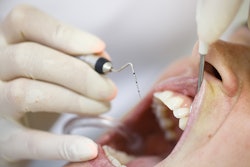Intraoral photography is wonderful and useful for crown, onlays, veneers, and core build-up claims. Time and time again I have recommended that the diagnosis and treatment details be documented in a well-written narrative -- one that can supplement your radiographic and photographic image(s).
 Dr. Dominique Fufidio.
Dr. Dominique Fufidio.
Technically, a narrative is any additional written information. It can be a single word, a sentence, or a page from a novel about the tooth and the patient’s treatment. Many times it is submitted on a claim form in box 35 of the ADA standard claim form. This is also known as the “remarks” section.
I love box 35, but it has its limitations -- it only can accept and display a certain number of characters. My suggestion for a claims submission best practice is to submit the narrative as an additional attachment or enclosure so the whole story of the tooth’s condition and treatment can be relayed.
If you make the narrative a separate attachment, you can add your supporting photos in the same place as your narrative, drawing attention to everything you wish reviewed in one place. Without relaying all the pertinent information, medical necessity may not be established with a radiograph or photo.
More often than I would have expected, offices submitted a copy of a checklist as their narrative. I love a checklist as part of my workflow, but it is simply not enough for a powerful, unquestionable, impactful narrative. A well-written narrative may have highly valuable information and may overturn an adverse determination. It is worth the time to elaborate on your checklist findings by entering details and more in the patient’s clinical treatment notes.
As for pertinent information capable of establishing medical necessity, this would be decay and decay into dentin, the extent of the decay as a percentage of the occlusal table it compromises, the amount of remaining tooth structure, a symptomatic cracked tooth, as well as your assessment of the tooth for the diagnosis, recurrent decay, etc., to name a few examples. On the list of etiology for an indirect restoration that may not establish medical necessity is wear, attrition, abrasion, and abfraction -- all with or without sensitivity.
Carriers popularly have exclusions for the above-mentioned conditions in the absence of dental caries. When I would do peer-to-peer calls, my peers would tell me, “But the tooth was sensitive.” When it comes to the medical necessity of an indirect restoration, sensitivity, in the absence of dental decay, does not meet the criteria for most carriers.
From an insurer’s perspective, there are ways to combat sensitivity. This means that a restoration is not the only viable option. Is there decay in the cervical area of the abfraction? Is there decay that has started in the areas of wear? If so, document this in your clinical progress notes and submit these as your narrative.
One helpful chairside diagnostic tool for indirect restorative treatment I commonly used in clinical practice was transillumination. Transillumination was impactful in demonstrating a crack to a patient, and I routinely acquired photos for documentation, added a note to my clinical progress notes, and used these to paint a story for my patients, helping them see what I was seeing.
An article by Lubisich et al titled “Cracked Teeth: A Review of the Literature,” discussed transillumination and its drawbacks, which is in line with the views of many payers in the dental insurance industry.
Lubisich explains how transillumination dramatizes cracks to a point where craze lines may look structural in nature.1 Additionally, there is ample supporting literature to back the perspective that not all cracks need treatment, a perspective also shared by many payers.
An article by Mamoun et al titled “Cracked Tooth Diagnosis and Treatment: An Alternative Paradigm” reviews common clinical examples of cracked teeth, including cusp fractures, fractures into furcations, and root fractures, going on to explain that a partial fracture is considered restorable and is done to prevent a catastrophic complete fracture, which would be unrestorable with a direct restoration. This article also reported that not all cracks and craze lines indicate a need for full coverage restorative treatment if they are not structural in nature.2
So although a patient, and their specific tooth, may benefit from having a full coverage restoration as a predictable, long-term, preventive treatment option, dental benefits are allocated for cases of true medical necessity. The asymptomatic tooth, with craze lines but no structural cracks, does not meet medical necessity criteria and typically is not benefited due to craze lines alone. Do your part to fully test the teeth with cracks and document the testing you have done to confirm the tooth does in fact have a symptomatic crack that requires a full-coverage restoration out of necessity.
As always, these tips are not a guarantee of coverage but are some recommendations based on hours of clinical claims review and time spent with insurance payers recognizing if the services performed meet their criteria to establish medical necessity. Insurers want to pay you for what you are doing!
References
- Lubisich EB, Hilton TJ, Ferracane J. Cracked teeth: A review of the literature. J Esthet Restor Dent. 2010;22:158-67.
- Mamoun JS, Napoletano D. Cracked tooth diagnosis and treatment: An alternative paradigm. Eur J Dent. 2015 Apr-Jun;9(2):293-303.
Dr. Dominique Fufidio is the CEO, founder, and main coach at Fufidio Consulting Group, which provides dental benefits reimbursement coaching based on her experience as a former dental insurance claims reviewer and a private practice owner.
The comments and observations expressed herein do not necessarily reflect the opinions of DrBicuspid.com, nor should they be construed as an endorsement or admonishment of any particular idea, vendor, or organization.




















